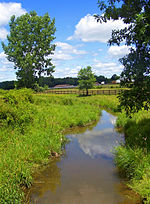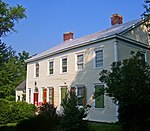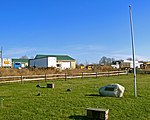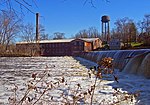Jacob Shafer House
Greek Revival houses in New York (state)Houses completed in 1842Houses in Orange County, New YorkHouses on the National Register of Historic Places in New York (state)Hudson Valley, New York Registered Historic Place stubs ... and 1 more
National Register of Historic Places in Orange County, New York

The Jacob Shafer House is a historic farmhouse located in Town of Montgomery in Orange County, New York. It is located on Kaisertown Road roughly a quarter-mile (400 m) south of NY 17K west of the village of Montgomery. The house was built about 1842, and is a two-story, three-bay, Greek Revival style frame dwelling with a 1+1⁄2-story wing. Also on the property are the contributing ruins of a barn complex and a stone lined well. It was built by Jacob Shafer, a prominent resident of the town.It was added to the National Register of Historic Places in 1996.
Excerpt from the Wikipedia article Jacob Shafer House (License: CC BY-SA 3.0, Authors, Images).Jacob Shafer House
Kaisertown Road,
Geographical coordinates (GPS) Address Nearby Places Show on map
Geographical coordinates (GPS)
| Latitude | Longitude |
|---|---|
| N 41.523055555556 ° | E -74.270555555556 ° |
Address
Kaisertown Road 338
12549
New York, United States
Open on Google Maps











